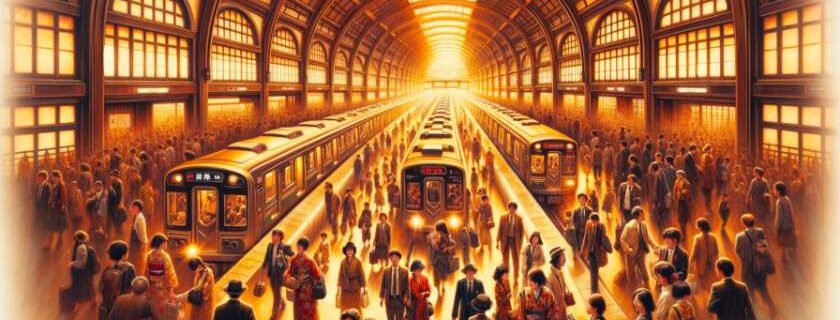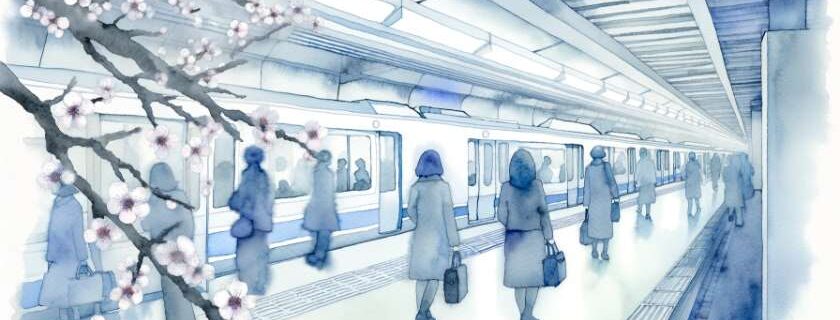
Ever wondered how to navigate the bustling city of Kyoto seamlessly? Look no further than the efficient and convenient Kyoto subways. Dive into this blog post to uncover insider tips, hidden gems, and must-know facts about getting around this vibrant city using the extensive subway system. From exploring historic landmarks to sampling delicious street food, these subways are your ticket to unlocking all that Kyoto has to offer. Ready to embark on a journey filled with adventure and discovery? Let’s dive deep into the world of Kyoto subways together!
- Key Takeaways
- Overview of Kyoto Subways
- Navigating Kyoto Subways
- Discount Passes And IC Cards
- Operational Hours And Fares
- Efficiency And Management
- Safety And Accessibility
- Comparison With Buses
- Tourist Guide For Easy Travel
- Future Of Kyoto Subways
- Final Remarks
- Frequently Asked Questions
- Is It Easy To Navigate The Kyoto Subways For First-Time Visitors?
- Are There Discount Passes Available For Traveling On Kyoto Subways?
- How Safe Are The Kyoto Subways For Passengers?
- What Makes Kyoto Subways More Efficient Compared To Buses?
- Can Tourists Easily Access Tourist Spots Using The Kyoto Subways?
Key Takeaways
- Utilize discount passes and IC cards for cost-effective travel on Kyoto subways.
- Plan your journey efficiently by understanding the operational hours and fares of Kyoto subways.
- Prioritize safety and accessibility while using Kyoto subways for a seamless travel experience.
- Consider the efficiency and management of Kyoto subways for a reliable mode of transportation.
- Opt for Kyoto subways over buses for a quicker and more convenient way to navigate the city.
- Stay informed about the future developments of Kyoto subways to enhance your travel experience.

Overview of Kyoto Subways
Karasuma Line
The Karasuma Line is a vital subway route in Kyoto, connecting the city’s northern and southern parts. It stops at key attractions like Nijo Castle[1] and the Kyoto Imperial Palace, making it convenient for tourists to explore historical sites. This line provides easy access to bustling shopping districts and diverse dining options, enhancing visitors’ overall experience in Kyoto.
Tozai Line
Running from the western suburbs to the eastern areas of Kyoto, the Tozai Line traverses through downtown zones and major tourist destinations. It facilitates seamless transfers to other subway lines, ensuring travelers can navigate different parts of the city efficiently. This line’s strategic route design allows passengers to explore various cultural landmarks and entertainment hubs with ease.
Major Railways
Operating two primary lines – the Karasuma Line and Tozai Line – Kyoto Subway plays a crucial role in providing comprehensive transportation services within the city. Its integration with JR West’s Sagano Line and Kintetsu Railway’s Kyoto Line expands connectivity beyond city limits into neighboring regions. This extensive network coverage not only benefits local commuters but also caters to tourists seeking convenient travel options around Kyoto.
Sightseeing Trains
In addition to regular services, Kyoto Subway offers unique sightseeing trains that enhance visitors’ experiences in Japan’s ancient capital. Travelers can immerse themselves in traditional Japanese culture aboard the Randen Arashiyama Line or enjoy picturesque views on the Sagano Romantic Train journey. These themed trains offer an alternative way for tourists to appreciate Kyoto’s rich heritage while enjoying scenic routes through captivating landscapes.
Navigating Kyoto Subways
Network Map
Kyoto’s subway system boasts a detailed map showcasing all lines, stations, and connections. This visual aid is available in various languages to cater to tourists’ needs. The map serves as a handy tool for travelers to effortlessly navigate through the intricate network of Kyoto Subways.
To illustrate, imagine having a trusty guide that lays out every stop and interchange point clearly. It’s like having a personal GPS system guiding you through the bustling underground world of Kyoto’s subways.
Transfers Guide
For seamless travel experiences, understanding how to transfer between different subway lines is key. By knowing the transfer stations and recommended routes, passengers can ensure a smooth journey across Kyoto’s subway network. These tips help commuters switch trains with ease, avoiding confusion or delays during their travels.
Think of it as having insider knowledge on which paths to take when changing from one line to another within the vast labyrinth of Kyoto Subways.
Street Routes
Exploring popular street routes accessible via Kyoto Subways unveils an array of vibrant experiences waiting to be discovered by passengers. From historic neighborhoods and charming shopping streets to bustling local markets, these routes offer an authentic taste of Kyoto’s rich culture and lively atmosphere. Travelers can immerse themselves in the city’s essence by following these intriguing pathways above ground after navigating through the underground maze.
Picture strolling down quaint alleyways lined with traditional wooden houses or browsing through eclectic stalls brimming with local crafts—all easily reachable using your newfound knowledge of street routes connected by Kyoto Subways.
Essential Points
Mastering essential information about utilizing Kyoto Subways efficiently is crucial for passengers looking for hassle-free travels around the city. Tips on ticket purchases, IC card usage, and fare guidelines enhance commuters’ understanding of how this transportation system operates smoothly day in and day out. Armed with these insights, travelers can confidently navigate through each step of their subway journey without any hiccups along the way.

Discount Passes And IC Cards
Passes Information
Kyoto Subways offers various discount passes for unlimited rides, catering to different travel needs. These passes come with diverse durations, costs, and benefits. For instance, the One-Day Subway Pass allows unlimited rides on subway lines for a day at a fixed price. On the other hand, the Kyoto Sightseeing Card offers not only subway access but also bus travel within certain zones.
To choose the most suitable pass for your itinerary, consider factors like how many days you plan to use public transportation and which areas you intend to visit frequently. By understanding each pass’s details and benefits, travelers can make an informed decision that aligns with their sightseeing plans in Kyoto.
- Pros:
- Cost-effective for multiple rides
- Convenient for frequent travelers
- Cons:
- Limited coverage area
- Not ideal for short stays
IC Cards Usage
IC cards, such as ICOCA or Suica cards, provide a convenient payment method for subway travel in Kyoto. These rechargeable smart cards eliminate the need to purchase tickets every time one boards the subway. To acquire an IC card, simply visit designated vending machines at subway stations or convenience stores.
After obtaining an IC card, users can easily charge it with desired amounts of money at ticket machines or service counters within stations. The card can then be swiftly tapped on entry gates when boarding trains or subways without any hassle of buying individual tickets each time.
- Steps to Use IC Cards:
- Purchase an IC card from vending machines.
- Charge the card with funds at station counters.
- Tap the card on entry gates while commuting.
Operational Hours And Fares
Hours Details
Kyoto Subways operate on varying schedules throughout the week, weekends, and holidays. Knowing the first and last train timings for each line is crucial for passengers to plan their journeys effectively. For instance, on weekdays, the subway may start running around 5:30 AM and end operations by midnight. However, these timings can differ slightly based on the specific line or station.
Understanding the operational hours ensures that passengers do not get stranded without transportation options late at night or early in the morning. By being aware of when services begin and cease on weekdays versus weekends or holidays, travelers can better organize their outings in Kyoto with confidence.
Fare Guidelines
When using Kyoto Subways, it’s essential to grasp how fares are calculated based on distance traveled accurately. This knowledge helps passengers avoid overpayment while commuting within the city efficiently. Knowing tips for preventing excessive charges and understanding fare adjustment rules can contribute significantly to saving money during travels.
Passengers should consider utilizing discount passes or IC cards mentioned earlier to further optimize their savings while using Kyoto Subways regularly. These tools not only streamline payment processes but also offer cost-effective solutions for frequent travelers looking to navigate the city conveniently.
Efficiency And Management
Passenger Increase
Kyoto Subways have experienced a significant rise in passenger numbers over the years. The statistics clearly show an upward trend, with more people opting for this mode of transportation. Factors like population growth, increased tourism, and the convenience of subway routes contribute to this popularity. Efficient public transportation is crucial for a city like Kyoto, known for its historical sites and cultural significance. With more passengers relying on subways, it becomes essential to ensure seamless operations.
The growing number of passengers underscores the importance of maintaining operational efficiency within Kyoto Subways. By focusing on operational excellence, the subway system can provide a reliable and punctual service to its riders. To achieve this, various measures are implemented to streamline processes, reduce delays, and enhance overall passenger experience. Punctuality is key in ensuring that commuters reach their destinations on time without disruptions or inconveniences.
Operational Efficiency
Kyoto Subway’s commitment to operational efficiency is evident through its dedication to providing a smooth and reliable service. The implementation of strategies such as regular maintenance schedules, real-time monitoring systems, and efficient staff training all contribute to running the subway system seamlessly. These efforts not only ensure trains run on time but also improve passenger satisfaction levels by offering a hassle-free commuting experience.
Efficient operations within Kyoto Subways do not only benefit passengers but also reflect positively on the city’s overall transportation network. When public transport functions smoothly, it encourages more people to choose sustainable modes of travel over private vehicles. This shift helps reduce traffic congestion, lower carbon emissions, and create a more environmentally friendly urban environment.

Safety And Accessibility
Safety Measures
Kyoto Subways prioritize passenger safety through various measures. Emergency response systems are in place to address any unforeseen circumstances promptly. Surveillance cameras are strategically located throughout the stations, enhancing security. Staff undergo rigorous training to handle emergencies efficiently, ensuring a safe environment for all passengers.
The implementation of these measures creates a secure setting for commuters. In times of need, the emergency response system acts as a vital tool for immediate assistance. Surveillance cameras not only deter potential incidents but also provide valuable footage for investigations when necessary.
Station Accessibility
Kyoto Subway stations boast excellent accessibility features catering to diverse needs. Elevators are available at key points within the stations, aiding individuals with mobility challenges or those carrying heavy luggage. Escalators provide convenience and ease of movement between different levels of the station.
These barrier-free facilities promote inclusivity by accommodating passengers with disabilities seamlessly. For instance, individuals using wheelchairs can navigate the station independently due to these thoughtful provisions. The presence of such amenities enhances the overall travel experience and ensures that everyone can access and enjoy Kyoto’s subway system effortlessly.
Comparison With Buses
Subway vs Bus Guide
Kyoto subways offer several advantages over buses, making them a popular choice for travelers. Subways are known for their speed, reliability, and extensive coverage throughout the city. Unlike buses that can get stuck in traffic, subways run on dedicated tracks underground, ensuring a smoother and faster journey from one point to another. This makes them ideal for those looking to navigate Kyoto efficiently and quickly.
One of the key benefits of using Kyoto’s subway system is its reliability. Subways operate on fixed schedules, reducing the risk of delays due to traffic or other external factors. Travelers can plan their journeys with confidence, knowing that they are likely to reach their destination on time. The extensive coverage of the subway network means that most major attractions and neighborhoods in Kyoto are easily accessible by train.
Combined Usage Tips
For an enhanced travel experience in Kyoto, consider combining subway travel with other modes of transportation like bicycles or taxis. By utilizing different modes of transport strategically, travelers can maximize flexibility and convenience during sightseeing excursions. For example:
- If you rent a bicycle near a subway station, you can explore areas not directly accessible by train.
- Using taxis for short distances from subway stations can save time and energy when visiting multiple locations in a day.
- Walking short distances between subway stops enables tourists to immerse themselves in Kyoto’s unique charm while moving between destinations effortlessly.
Tourist Guide For Easy Travel
Sightseeing Guide – Recommendations For Popular Tourist Attractions Accessible Via Kyoto Subways
Kyoto subways provide convenient access to various must-see spots like Fushimi Inari Taisha, a shrine famous for its thousands of vibrant torii gates. The subway system also connects tourists to the stunning Arashiyama Bamboo Grove, offering a tranquil walk surrounded by towering bamboo. Travelers can easily reach Kinkaku-ji Temple, known as the Golden Pavilion due to its breathtaking golden exterior.
For those interested in exploring traditional Japanese gardens, the Kyoto Imperial Palace Park is just a subway ride away. This expansive garden showcases meticulously manicured landscapes and serene ponds ideal for a leisurely stroll. By utilizing Kyoto subways efficiently, visitors can craft their itineraries to include these iconic cultural landmarks seamlessly.
- Convenient access to popular attractions
- Efficient itinerary planning
- Seamless connections to cultural landmarks
- Enhanced travel experience through easy transportation options
Discount Tips – Information On Discounted Fares And Special Passes While Using Kyoto Subways
Travelers looking to save money while sightseeing in Kyoto can benefit from various discount options available when using the city’s subway system. Special tourist passes offer unlimited rides within specific periods at reduced rates, making them cost-effective choices for exploring multiple attractions. Moreover, discounted fares during off-peak hours encourage budget-friendly travel without compromising on experiences.
By taking advantage of these cost-saving opportunities on Kyoto subways, tourists can allocate more resources towards immersive cultural activities or indulging in local cuisine without exceeding their budgets significantly.
- Special tourist passes with reduced rates
- Discounts during off-peak hours
- Cost-effective travel options for budget-conscious visitors
Future Of Kyoto Subways
Passenger Efforts
Passenger efforts play a crucial role in maintaining the Kyoto subways. By following subway etiquette and rules, travelers contribute to a pleasant commuting experience for everyone. Respecting fellow passengers, keeping the trains clean, and being mindful of noise levels are essential aspects that enhance the overall journey. When passengers actively participate in adhering to these guidelines, it creates a harmonious environment for all.
Encouraging passengers to maintain cleanliness not only ensures a hygienic setting but also reflects respect towards shared spaces. For instance, disposing of trash properly and avoiding littering on platforms or inside trains can significantly impact the overall ambiance. Showing consideration towards others by refraining from loud conversations or using headphones while listening to music helps in fostering a peaceful atmosphere during travel.
- Pros:
- Enhanced commuter experience
- Improved cleanliness and hygiene
- Respectful behavior among passengers
- Cons:
- Some travelers may require reminders or education on subway etiquette
Infrastructure Improvements
Ongoing infrastructure improvements within the Kyoto subways aim to elevate service quality continually. Through expansion plans, station renovations, and technology upgrades, the subway system is evolving to meet growing demands efficiently. Upgrading technologies such as automated ticketing systems or real-time passenger information enhances convenience for commuters while ensuring smoother operations for authorities.
By expanding existing lines or adding new routes strategically, Kyoto’s subway network can accommodate increasing passenger numbers effectively without compromising on service standards. Station renovations not only focus on aesthetic enhancements but also prioritize functionality and accessibility features for all travelers.
- Implement updates on ongoing infrastructure projects regularly.
- Conduct surveys among commuters to gather feedback for further improvements.
- Collaborate with urban planners to ensure sustainable development of subway networks.

Final Remarks
You’ve now mastered the ins and outs of navigating Kyoto subways like a pro. From understanding the system to exploring discounts and future possibilities, you’re all set to zip around the city hassle-free. Remember, the subway isn’t just about getting from A to B; it’s a glimpse into the heartbeat of Kyoto, where tradition meets modernity seamlessly. So, next time you hop on board, soak in the sights and sounds – it’s more than a ride; it’s an experience waiting to be embraced.
Ready to embark on your Kyoto subway adventure? Grab your IC card, map out your route, and dive into the vibrant tapestry of this historic city. Let the subway be your guide through temples, gardens, and hidden gems. Get ready to discover Kyoto like never before!
Frequently Asked Questions
Is It Easy To Navigate The Kyoto Subways For First-Time Visitors?
Navigating the Kyoto subways is straightforward, with clear signage in English and efficient routes. Maps are available at stations, and staff are helpful if you need assistance. Consider using mobile apps for real-time updates on schedules and routes.
Are There Discount Passes Available For Traveling On Kyoto Subways?
Yes, various discount passes like daily or multiple-day tickets are offered for unlimited subway rides within a specified period. IC cards such as Suica or Pasmo can also be used, providing convenience and savings on fares.
How Safe Are The Kyoto Subways For Passengers?
Kyoto subways prioritize passenger safety with regular security checks, emergency procedures in place, and well-lit stations. Security personnel monitor platforms to ensure orderliness during peak hours. Overall, it’s considered a safe mode of transportation in the city.
What Makes Kyoto Subways More Efficient Compared To Buses?
Kyoto subways offer faster travel times due to dedicated tracks without traffic congestion. Trains run frequently throughout the day, reducing waiting times significantly. The underground system also shields passengers from weather conditions above ground.
Can Tourists Easily Access Tourist Spots Using The Kyoto Subways?
Tourists find it convenient to access major tourist attractions via Kyoto subways due to strategic station locations near popular sites. Stations often have signs pointing towards landmarks outside exits, making navigation simple even without prior knowledge of the Japanese language.




